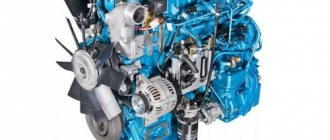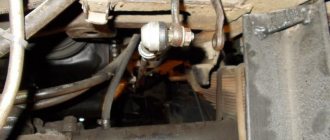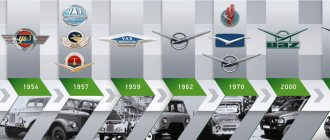Author: Vossen
March 17, 2016 11:40
Tags: GAZ 56 GAZ-51 gases history
3875
23
By the mid-thirties, the GAZ lorry, a licensed Ford AA, was outdated and there was a need for its replacement. Here it is - the bestial grin of capitalism: old Henry Ford, despite his ardent anti-communism, anti-Semitism and sympathy for the German National Socialists, all this did not stop him from cutting coupons from these same communists. However, the contract with Ford ended and Soviet designers developed the replacement for GAZ-AA themselves. Of course, they looked back at the Americans, but who didn’t look back at them back then!? Design of a new car with a six-cylinder in-line carburetor engine GAZ 11 with a power of 76 hp. s., which received the GAZ-51 brand, began in February 1937 under the leadership of designer V.M. Kudryavtseva. In June 1938, production of components began, in January 1939, assembly began, and already in May the first car entered road tests, which ended in July 1941. A number of sources call it GAZ-11-51, but in factory documents from the very beginning the car had the index “51” - the engine index did not appear in the names of GAZ truck models, unlike passenger cars of that time with the GAZ-11 engine, which were included in history with “11” in its index. In the summer of 1940, a prototype GAZ-51 was exhibited at the All-Union Agricultural Exhibition in Moscow. The second prototype, built in September 1940, after a run of 32,500 km, was equipped with a gas generator unit and worked at the plant for several more years. The tests were successful, and preparations began for serial production of the GAZ 51, which was to begin in 1942, at the beginning of the IV Five-Year Plan. But the outbreak of the Great Patriotic War disrupted these plans.
GAZ 11-51 Experienced '1939
0
Source:
Work on promising cars resumed in 1943. The rapid development of technology during the war years made inevitable adjustments to the design of the GAZ-51. Leading designer A.D. Prosvirnik (chief designer of the plant since 1968) radically reconfigured and modified the car, and essentially only the name remained from the pre-war GAZ-51. The accumulated experience in operating six-cylinder engines on combat vehicles has made it possible to significantly improve the engine and the systems that serve it. The carrying capacity was increased to 2.5 tons. However, the topic of the heir to the “lorry” was not abandoned.
0
Source:
0
Source:
Own face
On June 19, 1945, five days before the Victory Parade, at the famous automobile show in the Kremlin, the Soviet leadership was presented with samples of the GAZ-51 and GAZ-63, as well as the new Pobeda passenger models GAZ M-20 and GAZ M-25. Along with the Pobeda, the GAZ-51 was about to hit the assembly line, but in mid-1945 it became clear that the plant was simply not ready to properly provide the technological base for the mass production of the GAZ-51/GAZ-63. A situation arose in which it was necessary to choose between Pobeda and GAZ-51. The chief designer of the plant, Andrei Lipgart, nevertheless took upon himself responsibility and obligation - the plant will mass-produce both models no matter what. This was also a kind of feat. It was decided to produce the car with a cabin on a wooden frame lined with plywood, since the country's aluminum industry was still recovering after the war.
The first trial batch of cars rolled off the assembly line in January 1946. Small-scale production of the GAZ-51 began in June 1946, and large-scale production only from the end of 1947. The first batches of the new 2.5-ton vehicle began to be shipped to consumers in the summer, although state tests of the GAZ-51 car began only in the fall: the rush to complete the task affected them - only by the summer did they manage to complete factory tests. The state run was held from October 12 to November 5, the most difficult time for vehicle traffic, especially during the rainy season on dirt roads. In accordance with the test objective, a 5,403-kilometer route was chosen - from Gorky to Moscow, then across the entire territory of Ukraine, Moldova, Belarus and back through Moscow to Gorky. Eleven cars took part in the run, of which seven were GAZ-51 and four were service cars. As a result of the tests, the GAZ-51 car received high marks; its design is considered successful and modern. The commission made comments regarding the vehicle's cargo platform. Its dimensions (2940x1990x540 mm) and capacity of only 3.2 m3 (for bulk cargo) turned out to be insufficient. But the plant was no longer able to change the dimensions of the platform, otherwise there would have been a production pause in the production of cars that had just begun. Only in 1955, with the transition to the modernized GAZ-51A car, the internal dimensions of the platform were increased to 3080x2080x600 mm and they began to produce cars with both fixed and folding side walls - at the request of the customer.
Brief technical characteristics of experimental and pre-production GAZ-51 vehicles
| 1939 | 1943 (draft) | 1944 | 1945 | 1946 | |
| Load capacity, kg | 2000 | 2500 | |||
| Curb weight, kg | n.d. | 2940 | 2710 | 2750 | |
| Cabin type/step | All metal | Wooden | |||
| Hood | Streamlined | Alligator | |||
| Base, mm | 3300 | ||||
| Track, mm | 1600/1650 | 1585/1650 | 1590*/1650 | ||
| Overall dimensions, mm | 5450x(n.d.)x1800 | 5525x2200x2185 | 5525x 2200x 2130 | 5525x2215*x2115* | |
| Side height, mm | 540 | 890 | 540 | 550* | |
| Platform length, mm | 2750 | 2930 | 2940 | 2975 | |
| Platform width, mm | n.d. | 1900 | 1995 | ||
Engine:
| GAZ-11A 76 at 3600 min-1 | GAZ-11A 76 at 2800 min-1 | GAZ-51 70* at 2800 min-1 | ||
| Maximum speed, km/h | 70 | ||||
| Fuel consumption, l | n.d. | 28 | 22 | 20-22 | |
| Tank capacity, l | 100 | 100+120 | 90+105 | 105 | |
| Tire size | 7,00×20 | 7,5×20 | |||
*With regulator.
As for the 4x4 modification, in 1946 there was no talk of its serial production. According to the 1946 plan, one hundred copies of the GAZ-63 were to be produced, but neither in 1946 nor in 1947 the car plant could physically master the production of an all-wheel drive modification. The first GAZ-63 army trucks left the factory gates only in September 1948, five years after the production of the prototype and almost ten years after the start of development. In the same year, the plant built an experimental hooded bus, which had no prospects of becoming a serial one, and also began producing a short-wheelbase chassis for the GAZ-93 dump truck for the Odessa Automobile Assembly Plant. The first modifications of the GAZ-51 began to appear only at the turn of 1949–1950, after the last GAZ-MM lorry left the GAZ assembly shop on October 10, 1949.
For the GAZ-51, everything ended favorably - the model entered the production line, albeit with a wooden cabin, but with the Pobeda it turned out not so smoothly.
The production of the car was discontinued in August 1948 after assembling five thousand copies. There were enough shortcomings to suspend the production of the sedan for six months. Production of GAZ-51/GAZ-63 cars, pcs. in the early years
| 1945 | 1946 | 1947 | 1948 | |
| GAZ-51 | 2 | 2194 | 9344 | 26 890 |
| GAZ-51 chassis | 217 | 2470 | ||
| GAZ-51 chassis for GAZ-93 dump trucks | 2035 | |||
| GAZ-63 | 641 |
In 1947, the creators of the GAZ-51 car were awarded the Stalin Prize of the second degree; in 1949, a similar prize was awarded to the group of designers of the GAZ-63 car, led by Pyotr Muzyukin.
A lot has been written about the production car GAZ-51/ GAZ-51A and its modifications. The car was destined to become the most popular truck in the history of the USSR. This road worker was produced for thirty years (1946–1975), during which 3,481,033 cars were created.
A very clear picture: “ancestor” and heir” - GAZ-AA and GAZ-51
0
Source:
After the Victory, it was decided to return to the topic of a small delivery truck, which the Soviet national economy was in dire need of. The Ulyanovsk Automobile Plant was the first to create a new “lorry”, which began developing its first own model, called the UAZ-300, back in 1947. Ulyanovsk residents presented the first copy of the promising “lorry” at a festive demonstration on November 7, 1949. The first version of the car's appearance was very similar to the GAZ-51, but in 1948 the factory workers developed an original and very successful design. What’s interesting is that there was no full-time artist-designer at the plant at that time! GAZ employees offered their own version of the appearance, but theirs turned out to be more attractive.
Pre-war samples
Putting this epoch-making car on the assembly line was, frankly speaking, difficult. By 1940, the most popular car in the USSR - the GAZ-AA lorry - was morally outdated by a whole decade. In fact, from 1933 to 1941, the Gorky Automobile Plant developed and produced only one basic model - the M-1 sedan. Trucks and buses were nothing more than modifications of the basic lorry. Despite the fact that the Gorky residents independently carried out many developments, new modifications with a lot of “creaking” entered mass production. The GAZ-AAA three-axle truck and the GAZ-60 half-track all-terrain vehicle were developed at the Scientific Automotive and Tractor Institute, the remaining models were modifications. The situation was not going well. The “miracle” came, as always, from overseas. The driving force behind almost all new GAZ models is the in-line 6-cylinder Dodge engine.
This story began in 1937, when, on instructions from the Council of People's Commissars and through the Foreign Department of the NKVD, part of the drawings of the new Dodge D5 engine with a volume of 3.56 liters was illegally purchased from Chrysler employees for $25 thousand. On this basis, the GAZ-11 lower valve engine was modified to suit local conditions, resized to the metric system and adapted for production in Gorky. The lead designer of the project was Evgeny Agitov, deputy chief designer for engines. Converting inch dimensions to metric gave a slightly smaller working volume - 3.48 liters. The design differences of the GAZ-11 from the American prototype boiled down to the replacement of the camshaft chain drive with a gear drive and the introduction of a floating oil receiver into the lubrication system. The basic GAZ-11 engine with a cast-iron block head and a compression ratio of 5.6 developed 76 hp. and was first installed in 1938 on a modernized Emka with a phaeton body - model 11-40. A year later, a forced 85-horsepower version of the GAZ-11 A with an aluminum block head and a compression ratio of 6.2 was tested. The GAZ-11A reached the 100-horsepower mark in a two-carburetor version on the GL-1 racing car of the 1940 model. Before the Great Patriotic War, GAZ-11 engines were tested by the automobile plant in various conversions: in relation to training aircraft, river boats, armored vehicles and tracked tractors.
The 6-cylinder D-5 engine was used for the first time in a truck in the winter of 1937. A new engine and an enlarged radiator were installed on the standard semi-truck, and a number of cosmetic changes were also made to the front of the car. Despite the introduction of the GAZ-11 engine into mass production, at the plant at the turn of 1938–1939. They didn’t even think about equipping trucks with such an engine. There was no talk about a new generation of trucks either. On the contrary, since 1937, the Gorky residents began to implement a program of phased modernization of the lorry: the GAZ-AA car was turned into a GAZ-MM car by replacing some of the units with newly developed ones. It is noteworthy that in the history of the automotive industry there is no date that would mark the release of new GAZ-MM cars. She is absent. In 1937–1941 period, something new was introduced into the design of the base car. As a result, by 1941, the GAZ-MM was already in many ways different from the GAZ-AA of the 1937 model, although in essence it remained the same car.
Simultaneously with the modernization of the GAZ-AA car, another group of designers led by Vladimir Kudryavtsev began to develop a second-generation truck under the symbol 51. I note that in the United States, the Ford-AA semi-truck did not last long on the assembly line - until 1933. In the USSR, GAZ-AA was produced until 1949, representing, in fact, a twenty-year-old design. In July 1938, the production of prototypes began, the sets of which were ready by January 1939. The first sample was assembled in December 1938, the second only at the end of 1939 - they were in no hurry to assemble the second. In general, there was no rush to introduce the GAZ-51 into production.
In the literature, the car is called GAZ 11-51, but in factory documents from the very beginning, from the late 1930s, the car had an index of 51. The index 11-51 appeared along the chain of “damaged telephone” in the 90s of the last century. Double “Ford” indexation (engine-body) was not assigned to GAZ trucks.
The carrying capacity of the new car was two tons. The car was characterized by innovations: all-metal cabin; progressive layout (engine and cabin moved forward, which, with a relatively short base, made it possible to have a fairly long platform). Thanks to the 6-cylinder engine, the dynamic qualities of the car have significantly increased in comparison with the GAZ-MM. Increasing the safety margin of the structure made it possible to increase the traction force on the hook, thereby expanding the towing capabilities of the vehicle. When developing the car, the designers tried to correct the main shortcomings of the semi-truck, namely: a weak frame, overstressing the front and rear leaf spring suspension. The main focus was on increasing strength and overall increasing the reliability of the vehicle. Aspects such as safety and reducing driver fatigue were taken into account. As for the frame and chassis as a whole, first of all, a new rigid frame with a side member height of 150 mm and a rear cross-shaped cross member were created for the GAZ-51, which ensures good connection between the side members in the longitudinal direction. Special unloading braces were installed on the rear cross member (traverse), in the place where the towing device is attached. The suspension was made on four semi-elliptic springs with springs at the rear springs. A new type of front axle was introduced into the design of the car, characterized by increased rigidity of the steering arms, as well as increased dimensions of the steering knuckle and kingpin. The new front axle has significantly increased the vehicle's stability. A new type of reinforced steering wheel (type M-1; worm and double roller) and the introduction of two cardans between the gearbox and the rear axle were designed to increase the reliability of the new truck. The driver's work should have been ensured by the use of a centrifugal clutch, which required less effort when pressing the pedal. The truck received a modern three-seat streamlined cabin. But in order to introduce continuous production of such booths, it was necessary to purchase expensive dies and re-equip some of the equipment. At that time, the plant could not do this.
A group of designers led by Vitaly Grachev built a series of two- and three-axle all-wheel drive vehicles based on the GAZ-51 in 1939–1940. Simplified cabins were installed on these chassis in the absence of all-metal cabins of the new type:
- GAZ-32 – short-wheelbase vehicle (6×6), project;
- GAZ-33 – standard car (6x6);
- GAZ-34 – long-wheelbase car (6×6), project;
- GAZ-62 – short-wheelbase car (4×4);
- GAZ-63 is a standard car with a wheel arrangement (4x4).
Of these cars, fate favored only the GAZ-63, a variant of the GAZ-51 with a front drive axle. The “sixty-third” model was a one-and-a-half-ton vehicle capable of climbing inclines up to 30°, fords up to 0.8 m deep, and towing a trailer weighing 2 tons. Formally, in December 1939, after successful tests, such a lorry was adopted by the Red Army, but in production never went into production, just like the basic two-ton.
How could the famous GAZ-51 appear? The answer here lies more in the area of prestige than economic demand. In 1938, the country's automobile factories ZIS, GAZ and YaAZ privately demonstrated prototypes of second-generation cars. These were the GAZ-51, ZIS-15 and YAG-7 models, respectively. There was no government order for these cars! This was an attempt to draw the attention of the People's Commissariat of Medium Machine Building (NKSM) and the government to the existing technical gap, so they were manufactured purely on the factory initiative. At the end of the 1930s, industry concentrated on the production of military products. In 1939–1940, the sharp decline in car production was due only to this fact - GAZ began to gradually be loaded with orders for military products. Those “at the top” knew about the approaching war for a long time and prepared for it as best they could. The automotive industry de facto became a low priority; the main efforts were concentrated on the aircraft industry and, of course, on the tank industry.
In 1940, the chief designer of the automobile plant, Andrei Lipgart, reported: “A car, the production of which rejuvenates the plant’s products by ten years, does not have a “start in life” - no one at the plant knows when preparations for its production will begin and from what year it will be produced at the factory". Andrei Aleksandrovich could not have known then that the lack of production of the GAZ-51 car with the GAZ-11 engine in 1940–1941 would have a positive effect on the defense of our country in the Great Patriotic War. Postponing the launch of mass production of the GAZ-51 and equipping tanks, self-propelled guns and aircraft with GAZ-11 engines turned out to be much more important at that moment. In 1940–1943, the plant produced 130,000 lorries for the country. If we switched to producing a new model, GAZ simply would not have time to increase its production volume. The consequences could be catastrophic, since the lorry as a transport became at that time the main means of moving troops in a country with a gigantic territory.
In the Soviet Union, the GAZ-11 engine turned out to be not an automobile engine at all. First of all, it was a tank engine, a strategic object, which was distributed from above according to orders. And only in the post-war perspective, the improved lower-valve engine was considered as a single one for the entire line of wheeled and tracked GAZ vehicles, including even the Pobeda, and the 2.5-ton GAZ-51 truck became its new title carrier.
UAZ 302 Experienced '11.1950
0
Source:
0
Source:
One of the reasons was that in 1951 the Ulyanovsk Automobile Plant was transferred to another branch of industry, under the jurisdiction of the USSR Ministry of Radio Industry, becoming for a time a radio plant. Developments on the UAZ-300/302 were transferred to the Gorky Automobile Plant.
0
Source:
In 1952, the design of a new “one and a half” GAZ-56 began. Development began under the leadership of Alexander Dmitrievich Prosvirnin. Since August 1954, Alexander Butusov, a recent graduate of the Gorky Polytechnic, became the leading designer of the machine. This was the first serious (after designing caravans) task for the young designer.
GAZ 56 Experienced (I series) '1953–54
0
Source:
The design of the car contained a number of technical solutions unusual for its time: sealed drum brakes, a cam-type self-locking differential, a continuous rear axle housing and a hypoid final drive, telescopic shock absorbers, an overhead shaft engine with pre-chamber-torch ignition of the combustible mixture and an electric coupling for the cooling system fan, springs without grease nipple on rubber bushings. The layout of the car was traditional - hood.











